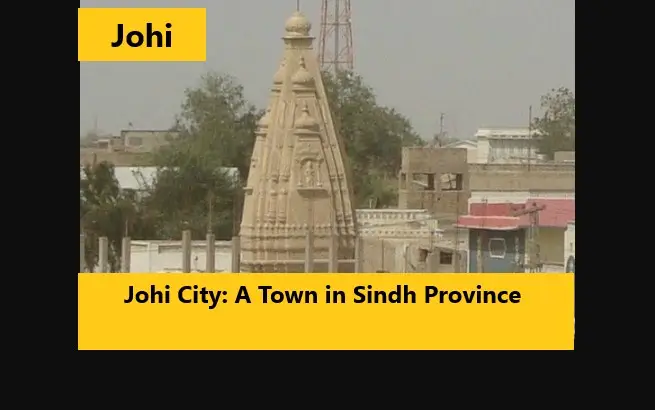Johi City: A Town in Sindh Province
Johi: Unveiling Sindh’s Hidden Gem Beyond the Gorakh Hill Station
Johi, an ancient town nestled in Sindh’s Dadu district, beckons travelers with its rich history and captivating beauty. This taluka of Dadu District borders Balochistan, offering a unique blend of cultures and landscapes.
Jewel in the Crown: The Enchanting Gorakh Hill Station
Undoubtedly, the crown jewel of Johi is the enchanting Gorakh Hill Station.
Often dubbed the “Murree of Sindh” for its cool climate, this hill station nestled within the Khirthar Mountains offers a refreshing escape from the scorching plains.
Read More: Park View City Phase II Islamabad
Beyond the Mountains: Unveiling Johi’s Treasures
But Johi’s charm extends far beyond the mountains. Here’s what awaits you:
- Gaji Shah Shrine and Gaaj Dam: Immerse yourself in serenity at the Gaaj Dam, a cascading wonder surrounding the revered shrine of Saint Gaji Shah.
- Angler’s Paradise: Casting a line becomes an adventure with Johi’s hidden fishing spots nestled amidst the scenic hillsides.
Planning Your Johi Adventure:
For those seeking a more detailed guide, keep scrolling through munafamarketing.com’s comprehensive Johi travelogue.
Quick Reference:
- Location: Dadu District, Sindh Province, Pakistan
- Coordinates: Latitude: 26.6921, Longitude: 67.6133 (26° 41′ 32″ North, 67° 36′ 48″ East)
- Altitude: 44 meters (144 feet)
Johi awaits! Embark on a journey to discover its hidden gems and experience the rich tapestry of Sindh.
Johi: Where Sindh Meets Balochistan
Johi’s unique location in Sindh’s Dadu district, bordering Balochistan, is a defining aspect of its charm. Nestled close to the provincial boundary, Johi thrives at the crossroads of these two distinct regions. This strategic positioning allows it to:
- Blend Cultural Fabrics: Johi draws inspiration from both Sindh and Balochistan, resulting in a fascinating cultural tapestry.
- Become an Administrative Hub: As a taluka, a vital administrative division, Johi plays a crucial role in Dadu District’s local governance.
This blend of cultural influences and administrative significance makes Johi a truly captivating destination.
How to Reach Johi, Sindh?
There isn’t an airport directly in Johi, Sindh. However, depending on your starting point and preferred mode of transportation, you have options to reach this charming town. Here’s a breakdown:
By Air
Since Johi lacks its own airport, the closest option is Sukkur Civil Airport (SKT), situated roughly 165 kilometers away.
Upon arrival at Sukkur Airport, you can hire a car or taxi to complete the journey to Johi.
By Train
Johi itself doesn’t have a train station. Dadu Railway Station, which is around 17 kilometers distant, is the closest major railway station. To go to Johi from Dadu, you can take a rickshaw or taxi.pen_spark
Opens in a new window en.wikipedia.org
Dadu Railway Station, Pakistan
By Road
The most practical way to get to Johi is by vehicle. Here’s a breakdown of travel from major cities:
- From Karachi: Travel 212 kilometers north on the National Highway N-55 from Karachi. Expect a trip of approximately seven hours and thirty minutes.
- From Sukkur: Travel around 140 kilometers south on the M-5 road. The journey should take about two hours and fifteen minutes.
- From Islamabad: This is a longer drive from Islamabad, taking about 1145 kilometers on the M-2 and M-5 motorways. Expect a travel time of roughly 13 hours.
Johi: Unveiling Its Rich History and Name’s Origins
Johi’s name carries whispers of its past. Derived from the Sindhi word “Juhi” or “Joohi,” meaning a “little clump of trees” (often considered feminine), the town’s name hints at its natural beginnings.
Legends of a Trading Hub:
Local folklore paints a picture of a small settlement named Nai, nestled beside a seasonal stream and a cluster of trees. Situated near an ancient trade route, these trees offered weary travelers and caravans a welcome respite.
From Rest Stop to Thriving Town:
Over time, the allure of this natural haven convinced some travelers to set down roots. A new settlement, named Juhi after the characteristic clump of trees, emerged. Interestingly, this name finds mention in British government records, solidifying its historical significance.
The Evolution of a Name:
The British colonial era subtly reshaped the town’s name. Juhi’s pronunciation gradually transformed into the present-day “Johi.” This subtle shift in pronunciation, though seemingly minor, highlights the town’s historical journey.
Johi: A Legacy Woven in Time
Today, Johi stands as a testament to its rich history. From its humble beginnings as a natural rest stop to its transformation into a thriving town, Johi’s story reflects resilience and growth.
Johi’s Enigmatic Past: Unveiling the Town’s Uncertain Origins
Johi’s history remains shrouded in a veil of mystery. While a definitive founding date eludes us, scattered pieces of the past hint at its potentially ancient origins.
Echoes of Buddhism:
Archaeological discoveries near Johi offer tantalizing clues. Buddhist shrines known as stupas, one housing the tomb of Najif Ali Shah and another in the nearby village of Gul Mohammad Gumb, whisper tales of a bygone era. These artifacts suggest Johi’s land may have once been a Buddhist settlement.
Historical Whispers:
Historical accounts lend further weight to this theory. Records mention the region being part of the Rai dynasty’s “Buddha” division (Pargana), further solidifying the past influence of Buddhism.
A Glimpse Through Dynastic Records:
We get another glimpse into Johi’s possible age from the Brahman dynasty. Historical accounts mention Kako, son of Kotal Chhana, ruling over a region known as “Buddha” with Sesum Fort as his capital. This suggests a pre-Rai dynasty settlement potentially existing in the Johi area.
A Call for Further Exploration:
While these connections are intriguing, they remain circumstantial. To truly understand Johi’s roots, further investigation and archaeological studies are crucial. Unearthing the town’s true origins will not only illuminate Johi’s past but also enrich our understanding of the region’s history.
Johi beckons us with its captivating present and the promise of a fascinating past waiting to be unearthed.
Johi’s Transformation: From Humble Beginnings to Thriving Town
While Johi’s exact origins remain elusive, its development becomes clearer when we delve into historical records.
A Glimpse from the Past:
A map dating back to 1877-1878 offers a snapshot of Johi’s early stages. Here, the town appears simply as a “Deh” (portion) of Tapa Phulji, signifying minimal development until the late 1800s.
The British Raj and Its Impact:
The arrival of the British Raj undeniably played a role in Johi’s evolution. Initially falling under the administrative control of Karachi, Johi later found itself under the jurisdiction of both Larkana and Shikarpur districts.
A Defining Moment:
The year 1931 marked a pivotal point in Johi’s history. The establishment of Dadu district saw Johi designated as its taluka headquarters. This decision proved to be a catalyst for significant growth.
Johi Today:
From its humble beginnings as a “Deh,” Johi has transformed into a well-recognized town within the Dadu district. This remarkable development journey reflects the town’s resilience and adaptability.
A Story Yet to be Fully Unfolded:
While the British Raj’s influence on Johi’s development is undeniable, a more complete picture likely lies beneath the surface. Further exploration of historical records and archaeological studies can shed light on the town’s pre-colonial past, potentially revealing even earlier chapters in Johi’s story.
Johi’s Enduring Legacy: The Shiva Mandir
Johi boasts a unique landmark that speaks volumes about the town’s rich history and religious heritage – the Shiva Mandir, locally known as “Qubi.” Dedicated to Lord Shiva, this nearly 200-year-old Hindu temple stands as a testament to the area’s enduring faith.
An Architectural Gem:
The Shiva Mandir’s remarkable architectural style sets it apart. It features two distinct dome-shaped structures:
- The towering Qubi: This majestic central dome dominates the landscape, reaching an impressive height of 70 feet.
- A companion dome: A smaller, rounded dome flanks the Qubi, adding a touch of balance to the overall design.
A Glimpse into the Past:
While the temple’s domes originally displayed idols, these were unfortunately removed after the 1947 Partition. However, the exterior walls still bear remnants of these past adornments, offering a silent testament to the temple’s history.
A Legacy that Endures:
Despite undergoing alterations over time, the Shiva Mandir remains a significant monument in Johi. Its presence not only serves as a place of worship for the Hindu community but also stands as a powerful symbol of the region’s rich religious tapestry.
Beyond the Temple Walls:
The existence of the Shiva Mandir strengthens the belief that Shiva worship has flourished in this area for centuries. This notion is further supported by the historical fact that Sehwan, a nearby city, was originally known as Siwistan, a name with clear links to Lord Shiva.
Johi’s Shiva Mandir – A Beacon of History and Faith
The Shiva Mandir stands as a captivating blend of architectural wonder and historical significance. It serves as a reminder of Johi’s diverse past and the enduring power of faith.
Johi: A Blend of Bountiful Harvest and Pressing Needs
Johi’s landscape, sculpted by the mighty Indus River, presents a vibrant tapestry of agricultural activity. Throughout the year, farmers diligently cultivate a diverse range of crops, capitalizing on both summer (kharif) and winter (rabi) seasons.
A Bounty of Crops:
- Kharif Season: Fields teem with rice, sugarcane, the “white gold” of cotton, and life-sustaining maize.
- Rabi Season: Wheat, the staple food, takes center stage alongside jowar, barley, and tobacco. Additionally, crops like gram, bajra, sesame, and even pulses like masoor flourish during this time.
Beyond these staples, oilseeds like safflower, rapeseed, and linseed add another layer of variety to Johi’s agricultural landscape. Modern crops like sugar beet, sunflower, and canola are also making their presence felt.
Challenges Amidst Abundance:
Despite its rich agricultural heritage, Johi faces significant challenges. Limited water resources threaten this fertile land, and inadequate infrastructure hinders progress. News reports highlight the struggles of Johi’s residents as they strive for essential resources and fundamental rights.
A Call for Sustainable Solutions:
To ensure Johi’s future as a flourishing agricultural hub, implementing sustainable water management practices and investing in infrastructure are crucial. Addressing the needs of the local population will not only improve their lives but also empower them to cultivate Johi’s agricultural potential to its fullest.
Johi’s story is one of resilience, adaptation, and a deep connection to the land. By acknowledging both its bounty and its challenges, we can work towards a future where Johi thrives not just as an agricultural center, but as a vibrant and empowered community.
Note: The information above might not be accepted 100%. Please verify from your own sources. We will not be responsible for any kind of loss due to our content.
For more news, please visit Munafa Marketing.




